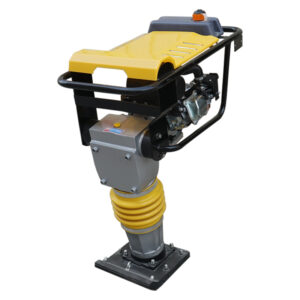This article will give you basic information about the working of a road roller and the various types of road roller available in the market. A road roller is a compactor-type engineering vehicle used in the building of roads and foundations to crush dirt, gravel, concrete, or asphalt. Road rollers are also used in agriculture and landfills. The rolling technique ensures that foundations are completely compacted, ensuring that materials do not break free. Basic characteristics include a diesel engine, a cover to protect the driver, a drum(s) that can be either vibratory or static smooth, tyres, a compaction metre to monitor the amount of compaction, and a water system.
Types of road rollers
- Roller with a single drum
A single drum roller is a large piece of equipment. The front features a massive drum, while the back has unique tyres. These tyres are more durable and can avoid most flats. When working on construction sites and roadways, you’ll need these heavy-duty tyres. The driver sits in the centre part of the single drum roller. The cab is the name for this section. It is situated high, providing the motorist with a panoramic view of the surrounding region. The worker can observe the areas where the roller will be used.
- Vibratory Roller
A vibratory roller is similar to a cylinder roller in appearance. An internal eccentric shaft causes the wheel drums to vibrate, which sets it apart. Its vibratory action greatly expands its capabilities. As a result, they’re more often employed in granular base layer applications. They’re also sometimes used in highway construction to lay asphalt. The vibratory characteristics minimise the gap between particles in the materials being compressed, resulting in denser layers that provide the foundation more depth. The oscillations from it also force the particles to lay closer together as a result of the vibrations.
- Cylinder Roller
These are the most often used rollers nowadays. They are the most basic form of road roller, using a conventional cylinder drum. The majority of them are single-drum rollers, however there are few that have two drums. Road rollers of this sort are typically used to compact stone or other similar materials into flat ground. They’re said to function best when you apply surface treatments to make the surface even smoother and flatter.
- Rubber-Tyred Roller
Instead of the traditional wheel drums, these rollers contain multiple rows of closely spaced pneumatic tyres in both the front and back of the machine. These tyres are likewise staggered to apply compacting pressure throughout the whole machine’s breadth. Soft materials and lightly compacted soils are ideal for these rollers. They are also used in highway construction, especially for smoothing bitumen on some roadworks.
- Pneumatic Rollers
Pneumatic rollers, also known as pneumatic tyred rollers, are a big ride-on roller having many rows of rubber tyres on the front and back ends. The rubber tyres cover 80% of the tire’s surface area and maintain a consistent pressure across the tire’s breadth.They’re commonly used for pavements and may assist smooth out and polish a project, but they’re also fantastic for loose soil layers and cold-laid bituminous or cold mixed pavements.
Conclusion
A road roller has a lot of requirements, and the operator needs to be able to complete the project quickly. With this in mind, the road roller is ideal because it is capable of handling all of the project’s requirements. An excellent road roller gives you a sensation of power, and you should get one as quickly as possible. The appropriate road roller may meet all of your needs while also maximising the job you’re doing, therefore one must search for an appropriate road roller manufacturer.


